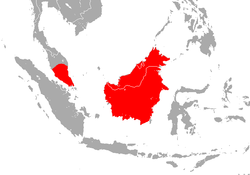| Rhinolophus sedulus | |
|---|---|
| Scientific classification | |
| Kingdom: | Animalia |
| Phylum: | Chordata |
| Class: | Mammalia |
| Order: | Chiroptera |
| Family: | Rhinolophidae |
| Genus: | Rhinolophus |
| Species: | R. sedulus |
| Binomial name | |
| Rhinolophus sedulus K. Andersen, 1905 | |
 | |
| Rhinolophus sedulus range | |
The lesser woolly horseshoe bat (Rhinolophus sedulus) is a species of bat in the family Rhinolophidae. It is found in Brunei, Indonesia, and Malaysia. It is assessed as near-threatened by the IUCN. [2]
